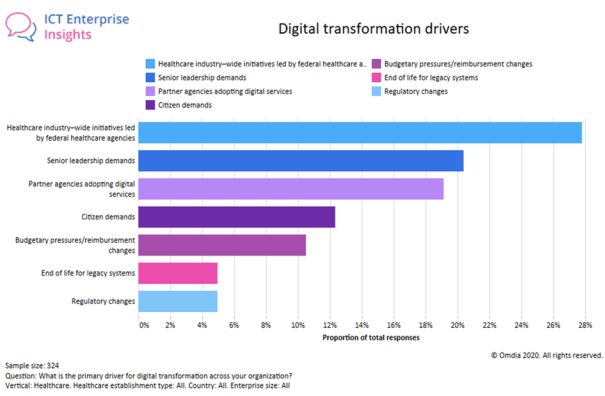As with nearly every aspect of life in 2020, the coronavirus disease 2019 (COVID-19) made for a unique, virtual Radiological Society of North America (RSNA) Annual Meeting. While RSNA 2020 still showcased its usual lineup of major product launches, research findings, and technologies, COVID-19 was the main story of the conference. The health crisis has stimulated a groundswell of innovation in the medical community, including advancements in artificial intelligence (AI), digital transformation, telemedicine, product launches, and new healthcare infrastructure. Such innovations were featured at RSNA 2020 and provide insight to the outlook of the healthcare industry as we enter 2021.
The case for healthcare AI continues to grow
A confluence of factors promoting the rapid adoption of healthcare AI is expected to make 2021 a pivotal year for the technology. Recent improvements to the diagnostic and time saving capabilities of AI products offer healthcare providers practical solutions to real-world healthcare challenges. In recent years, AI has had an increasingly high profile at RSNA, becoming a major theme of the conference. This was certainly the case in 2020 as many new AI solutions were on display. For example, CureMetrix showcased the results of a study that found that its AI software improved radiologists’ diagnostic accuracy and specificity by 25% and 34% respectively, and reduced the time required to read normal exams when interpreting mammograms (Source: CureMetrix). AI software is pivotal in nations with a shortage of experienced radiologists and will drive growth for the mammography equipment market. Omdia forecasts that after a sharp decline in 2020, mammography equipment revenue will grow at a compound annual growth rate (CAGR) of over 7% from 2020 to 2024.
While the organic expansion of the healthcare AI market was projected, the unforeseen health crisis caused by COVID-19 has acted as a significant accelerant. Omdia estimated that COVID-19 will increase healthcare AI revenue in 2021, resulting in an overall 84% year-over-year (YoY) growth, representing a change of 26% YoY from pre-COVID-19 estimates. Efficient and effective COVID-19 diagnoses are of upmost importance during the pandemic, which has accelerated the development of AI software in the healthcare sector. Further government investment in AI-based drug and vaccine research, medical imaging, and machine learning tools for patient screening, triage, and monitoring is also expected. At RSNA 2020, RADLogics showcased its latest iteration of AI solutions designed to detect symptoms of COVID-19 from CT and X-ray images, two modalities which have been heavily relied upon during the pandemic (Source: RADLogics). As a result of the increased demand caused by COVID-19, Omdia estimated CT and general radiography X-ray equipment revenue grew by 5% and 14% respectively in 2020, while overall medical imaging revenue declined by 8%.
Figure 1: COVID-19 forecast effect on AI software industries

Source: Omdia
Collaboration between AI vendors, healthcare equipment manufacturers, and healthcare providers are set to drive further AI development and adoption in 2021 and beyond. At RSNA 2020, NVIDIA announced the launch of the Inception Alliance program which will facilitate partnerships between medical imaging AI startups, GE Healthcare, and Nuance (Source: NVIDIA). The program aims to fast-track development of AI for healthcare and link software development with the medical imaging community. Collaborations like the Inception Alliance will help healthcare AI take the next step in its expansion as advanced technological developments will be guided by real-world healthcare challenges.
To reach its full potential in the healthcare market, AI technology adoption must overcome daunting barriers including information technology (IT) and workflow integration. At the annual meeting, GE Healthcare featured advancements to its Edison AI platform that help address these challenges. Not only does Edison offer AI applications to improve diagnostics and workflow efficiency, the platform also includes the Edison Open AI Orchestrator, which simplifies the implementation of AI into radiology workflows (Source: GE Healthcare). Recent developments around another AI adoption barrier, regulation, may also drive additional healthcare AI acceptance in 2021. In its action plan for medical AI published in January 2021, the US Food and Drug Administration (FDA) outlines its strategy to collaborate with the medical community to develop effective methodologies to evaluate and monitor algorithms. If the FDA’s plan is effective, it will provide clear process and guidelines for AI approval.
COVID-19 is accelerating healthcare digital transformation
The lack of access to adequate medical care predated COVID-19 and remains a major challenge for communities – especially rural and impoverished – around the world. While COVID-19 intensified many existing healthcare challenges – including worker shortages – it also acted as a catalyst to drive progress in delivering more effective healthcare to patients. One of the key trends observed at RSNA 2020 was the rapid acceleration and adoption of digital transformation technologies in the healthcare industry. However, the transformation process represents several challenges which must be overcome; these include:
- High cost and complexity of integrating new technologies
- Lack of compatibility with legacy platforms
- Data protection and cybersecurity
- Compliance with a dynamic regulatory environment
Irrespective of these challenges, healthcare environments have seen an acceleration in the adoption of cloud-based enterprise imaging platforms. Such technologies have numerous advantages, including improved disaster recovery, budgeting flexibility, and a reduction in hospital IT staff support. The increasing demand for medical imaging will necessitate hospitals to employ a forward-thinking approach to upgrading enterprise imaging ecosystems. As part of Omdia’s 2020 Information and Communications Technology (ICT) Enterprise Insights, over 300 healthcare ICT professionals were surveyed about digital transformation. These healthcare providers identified government initiatives, internal business demands, and partner agencies adopting digital services as the top three drivers for digital transformation.
Figure 2: ICT Enterprise Insights – Digital transformation drivers

Source: Omdia
The pandemic has also transformed the medical imaging work environment. Radiology departments have started to capture a large volume of new patient data as they deal with high volumes of COVID-19 cases. Increasing data collection has driven additional value in evaluating metrics, such as patient outcome efficacy and system return on investment (ROI). Data science deployed by hospitals is forecast to aid diagnosis and treatment of patients across all healthcare specialties.
At RSNA 2020, Philips Healthcare launched its Radiology Operations Command Center (ROCC), a digital platform that aims to serve as a centralized hub to improve communication and data exchange between radiologists, administrators, technologists, and IT personnel across multiple imaging sites (Source: Philips). In 2021, Omdia forecasts the continued development of products in this space from multinational healthcare technology manufacturers, as they aim to streamline healthcare workflows and address radiologists’ challenges.
Telemedicine demonstrates industry-altering benefits
Telemedicine has become a vital technology in the world of healthcare, especially during the pandemic. Advancements in telemedicine technology have improved patients’ access to remote healthcare providers, helping to reduce the spread of COVID-19. Regulations on the use of telemedicine have been eased, as demand for the technology surged in 2020 in response to the pandemic. With broader utilization of telemedicine, demand is expected to remain strong in 2021 and beyond, as patients benefit from leveraging diagnosis and care remotely and healthcare providers build telemedicine services to accommodate the pandemic environment that establish new business models and generate alternative revenue streams. Telemedicine can yield earlier detection and diagnosis, improved patient outcomes and satisfaction, and lower cost of care. These benefits are a product of the technology’s ability to improve and streamline patients’ access to quality healthcare by enabling examinations to be conducted from home or local facilities. In the case of medical imaging, radiologists can remotely guide medical staff at point-of-care imaging facilities during scan acquisition and then review scans remotely.
Figure 3: Benefits of telemedicine

Source: Omdia
The ongoing success of the technology is largely dependent on the development of new telemedicine solutions and applications; a number were showcased at RSNA 2020. For example, Konica Minolta introduced its Exa Gateway, which is a teleradiology platform that connects remote radiologists with healthcare practices, utilizing facilities’ existing picture archiving and communication systems (PACS) to minimize cost (Source: Konica Minolta). Additionally, USARad announced a new patent for a decentralized method designed to enhance the telemedicine workflow by matching radiologists with healthcare facilities and AI vendors (Source: Cision PRWeb). Solutions like these enhance the benefits of telemedicine and will help to cement the technology’s place in the healthcare market even after the pandemic.
Product launches meet demand for systems that increase access to medical imaging
While COVID-19 halted physical events in 2020, virtual exhibitions enabled healthcare equipment manufacturers to feature latest innovations. Like most years, RSNA featured the introduction of numerous medical imaging product lines, including the following from top players:
Figure 4: Medical imaging product launches from several top manufacturers at RSNA 2020

Source: Omdia
Many of these launches, such as multiple C-arm and point-of-care ultrasound systems, represent efforts to develop and deploy ambulatory care systems as part of an industry-wide theme of increasing patients’ access to medical imaging. Point-of-care medical imaging improves patient outcomes and by increasing the likelihood of early detection and diagnosis and reduces patients’ costs for care. Healthcare providers also benefit by increasing patient throughput and by utilizing lower-cost systems for simpler cases, which frees up hospital space and systems for advanced cases.
In 2021, Omdia forecasts the continued development of bedside technology and ambulatory care systems aimed at easing the burden on hospitals that are struggling to provide critical care to COVID-19 patients.
The healthcare industry is learning from the pandemic and preparing for the future
Research presented at RSNA displayed the tremendous amount that the medical community has learned about COVID-19, including studies on comorbidities and non-pulmonary complications and award-winning findings on CT being used to detect COVID-19 (Source: RSNA). Research and experience have enabled healthcare providers to improve approaches to diagnosing and treating COVID-19 patients and manufacturers quickly played their part by providing resources and tools, many of which were on display at RSNA. Solutions ranged from point-of-care medical imaging equipment to 3D-printed nasal swabs and predictive COVID-19 algorithms. Out of necessity, the pandemic forced the industry to pursue and invest in new technologies like AI and telehealth, which will continue to gain prevalence and become standard in the “new normal” for the healthcare industry in 2021 and beyond. The pandemic also exacerbated the industry’s preexisting issues, including workforce shortages, strained healthcare provisions, and burnout. Following the worst of the pandemic, the medical community and governments will need to seek to address these issues, futureproof against other health crises, and treat the long-term medical complications of COVID-19.
On December 8, 2020, the UK began administering the western world’s first COVID-19 vaccination and the US followed suit the next week. While effective global distribution will be difficult, the development of vaccines within a year of the pandemic beginning is a tremendous feat and signaled the beginning of the end of the pandemic. In 2021, the healthcare industry will look to settle into the “new normal”, but will face sizeable headwinds, including heightened budget constraints following the overextension of resources during the pandemic. 2020 served as proof of the healthcare industry’s immense capabilities for ingenuity through collaboration and innovation, which will continue to be in high demand in 2021.
For more insights from Omdia, click here.


